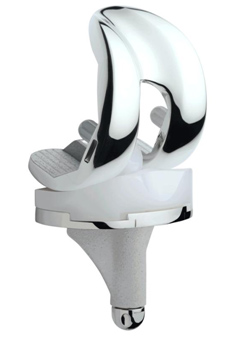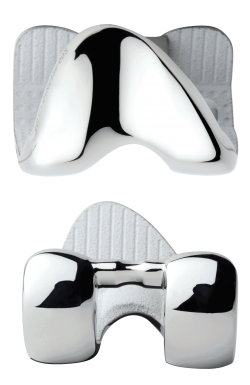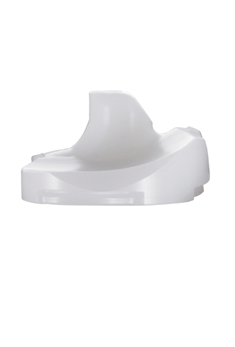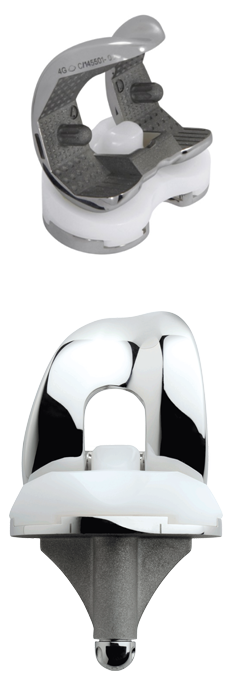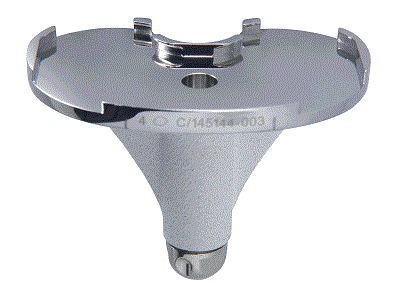Anatomic
Description
HIGHLIGHTS
Posterior-stabilised, fixed bearing, primary total knee replacement
- Mediolateral implant coverage matches bone morphology
- Stability and range of motion are ensured:
– in extension by congruent anterior rim
– in deep flexion by delayed contact between post/cam stabilization mechanism
- Cemented and cementless versions: Plasma-sprayed Titanium (80 μm) and HAP (80 μm)
FEMORAL COMPONEN
- Anatomic femoral component design based on a study of 420 knees digitized using the AMPLIVISION® navigation
- Lateralised trochlear groove better reproduces natural anatomy
- Centred cage is proportionately scaled, thereby preserving bone stock
- Posterior stabilisation cam ensures stability during flexion while allowing adequate rotational movements
- Single radius of curvature from 0° to 100° flexion. Radius of curvature then decreases at posterior aspect of condyles to allow for high flexion
- 6° anterior cut preserves the cortex
- Only 2.6 mm difference in anteroposterior height between sizes and in mediolateral (between 2 and 3.2 mm)
- Material : Cobalt-chrome (CoCr)
INSERT
- Insert has curved anterior lip to ensure joint stability throughout range of motion. Posterior stabilisation (PS) mechanism engages when knee is flexed more than 90°
- Planar surface (large radius) posteriorly allows lateral compartment to roll
- Polyethylene insert is thicker in posteroinferior part of post where it makes contact with PS cam
- Material: Machined ultra-high molecular weight polyethylene (UHMWPE)
PATELLAS
- nsert has curved anterior lip to ensure joint stability throughout range of motion. Posterior stabilisation (PS) mechanism engages when knee is flexed more than 90°
- Planar surface (large radius) posteriorly allows lateral compartment to roll
- Polyethylene insert is thicker in posteroinferior part of post where it makes contact with PS cam
- Material: Machined ultra-high molecular weight polyethylene (UHMWPE)
KINEMATICS
- Middle of PS cam is rounded to allow condyles to rotate around post
- Contact between PS cam and post beyond 90° flexion and posterior displacement of femoral component allow for deep flexion while ensuring stability
- Up to 10° recurvatum possible
- PE insert is thickest posteriorly to support posterior aspect of condyles
- Femoral component and insert can either be matched size-for-size or combined with implant one size above or below
RANGE
CONDYLES
- Cementless, HAP-coated femoral condyle: sizes 1 to 7, Right (Optional: sizes 0 & 8)
- Cementless, HAP-coated femoral condyle: sizes 1 to 7, Left (Optional: sizes 0 & 8)
- Cemented femoral condyle: sizes 1 to 7, Right (Optional: sizes 0 & 8)
- Cemented femoral condyle: sizes 1 to 7, Left (Optional: sizes 0 & 8)
BASEPLATE
- Cementless, HAP-coated tibial baseplate for fixed insert: sizes 1 to 7 (Optional: sizes 0 & 8)
- Cemented, tibial baseplate for fixed insert: sizes 1 to 7 (Optional: sizes 0 & 8)
INSERT
- Fixed insert: sizes 1 to 7; thickness: 10, 12, 14, 16, 18 and 20 mm (Optional: sizes 0 & 8)
PATELLAS
- Resurfacing patella: Ø 30, 33, 36 mm
- Embedded patella using reaming: Ø 23, 26, 29 mm

